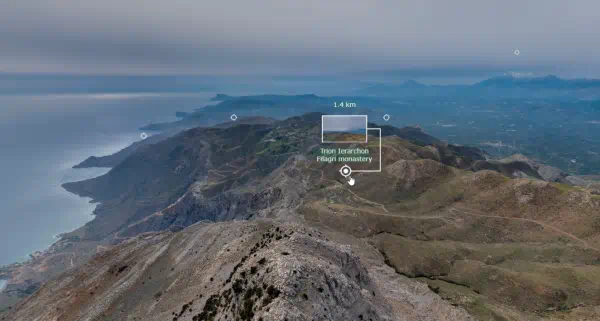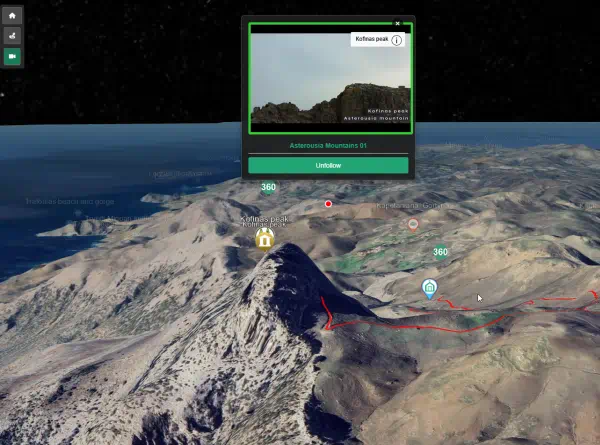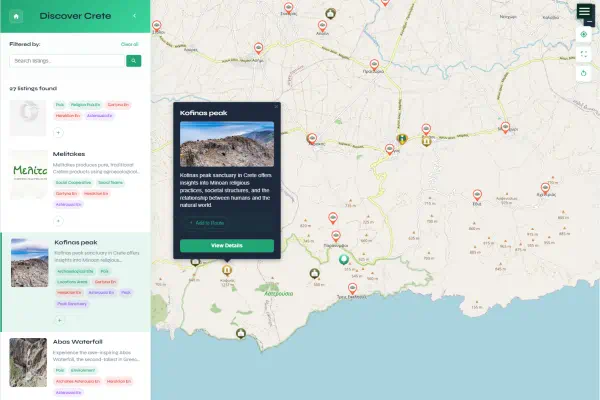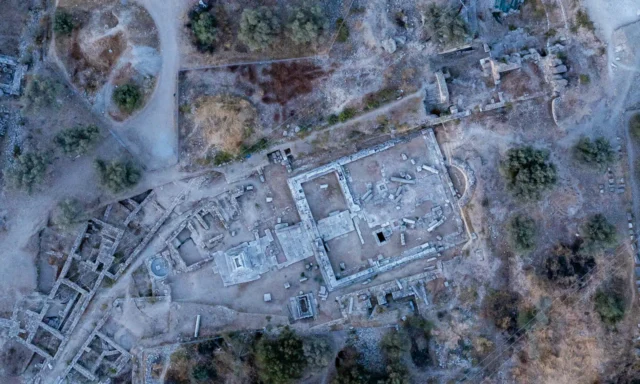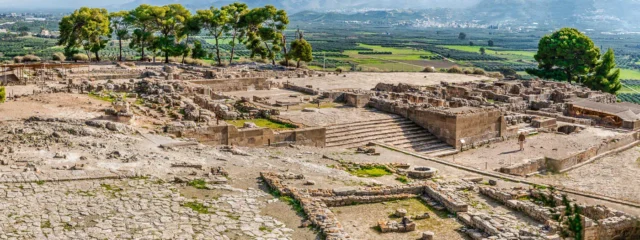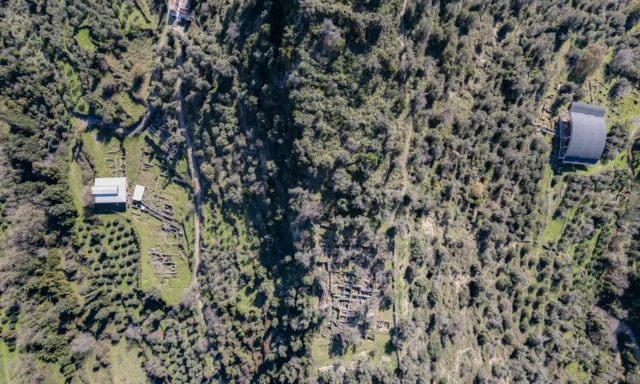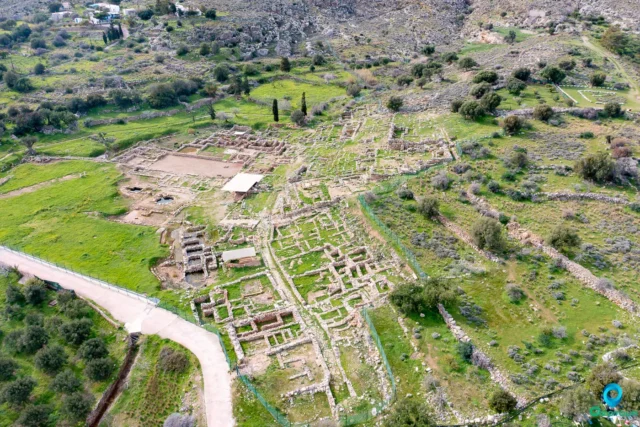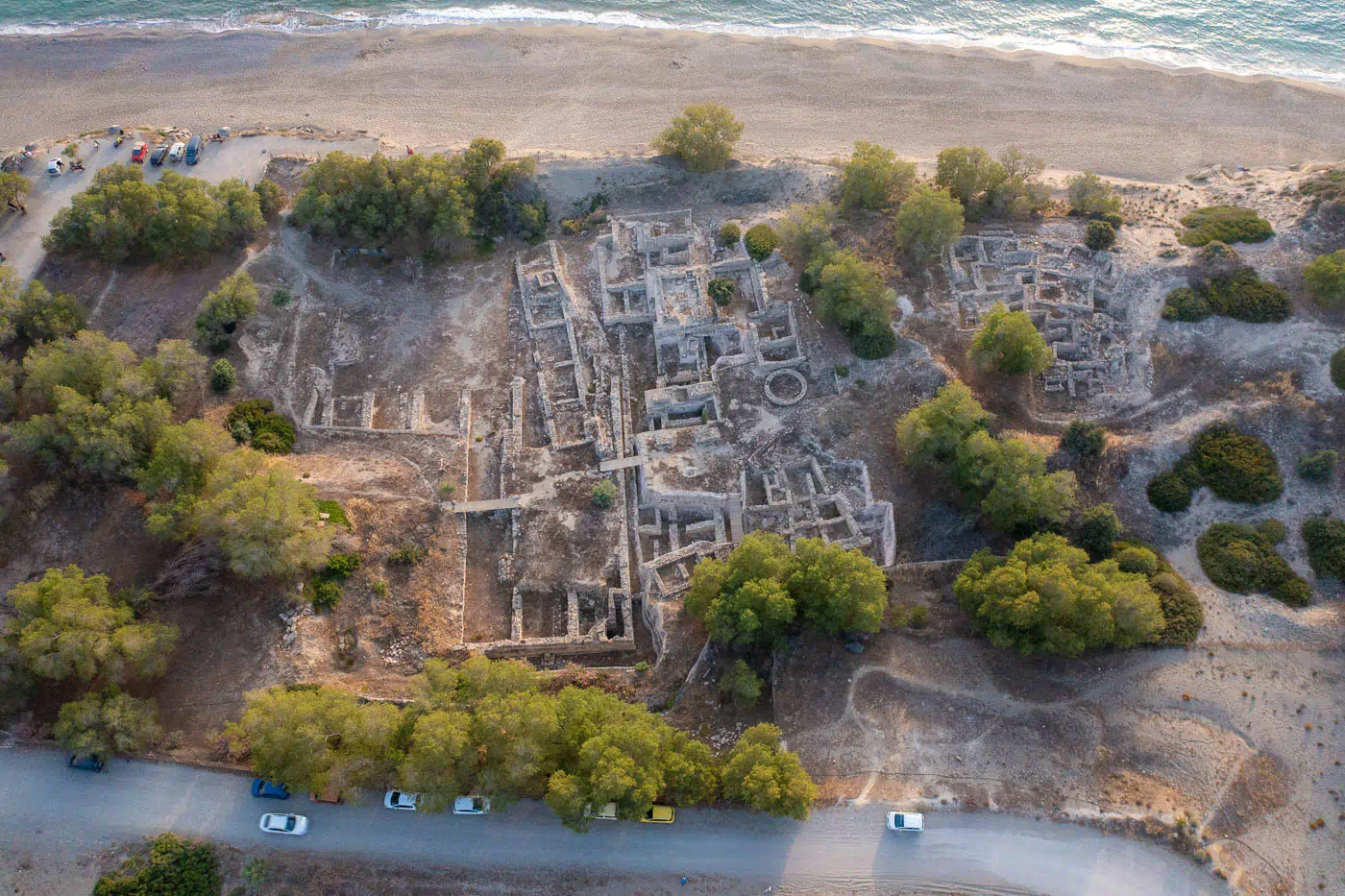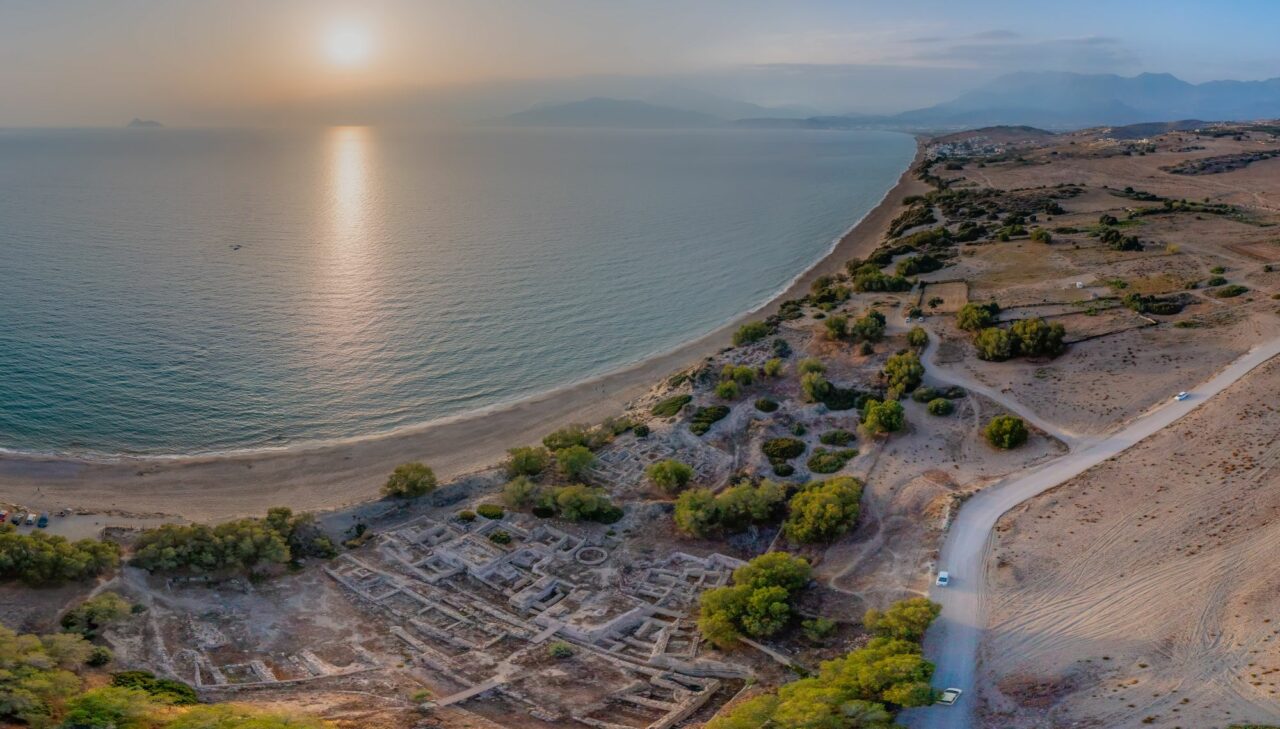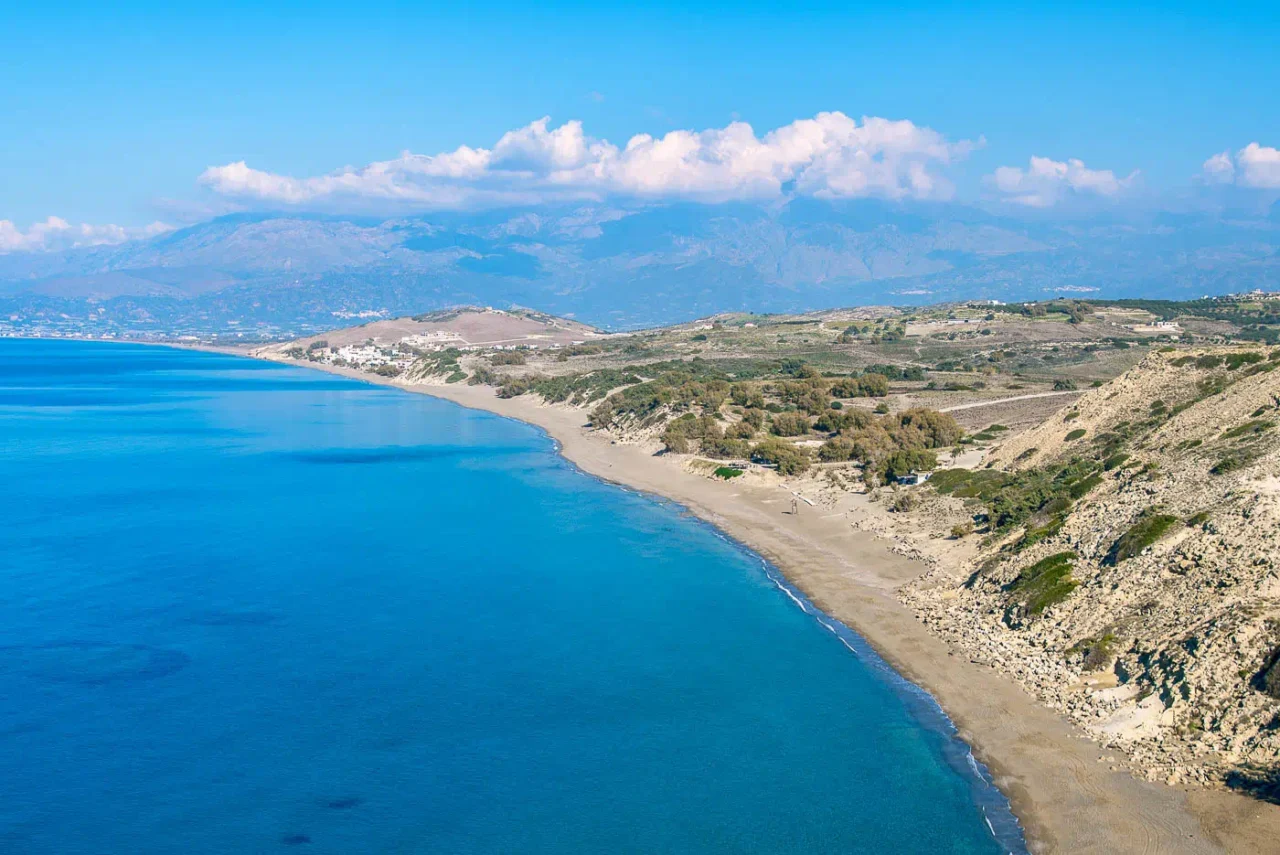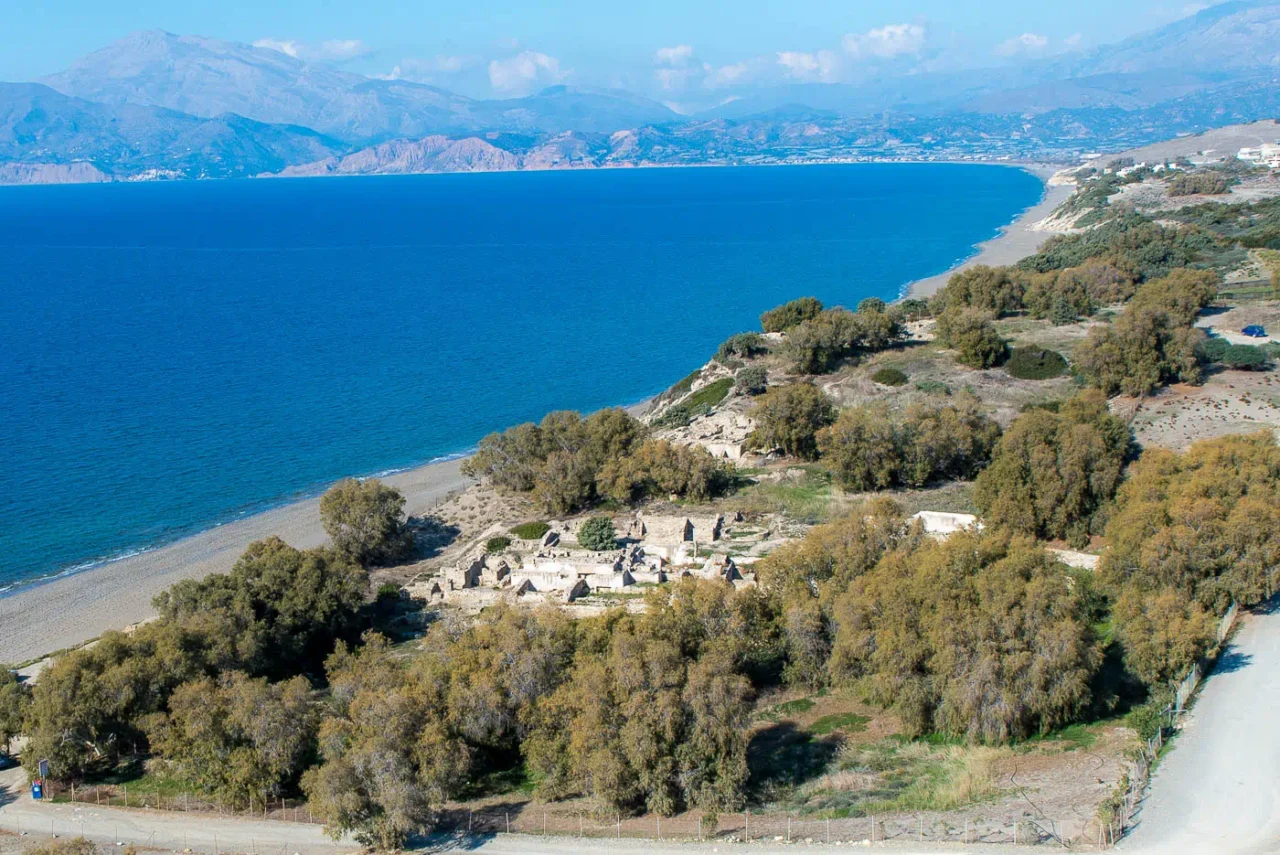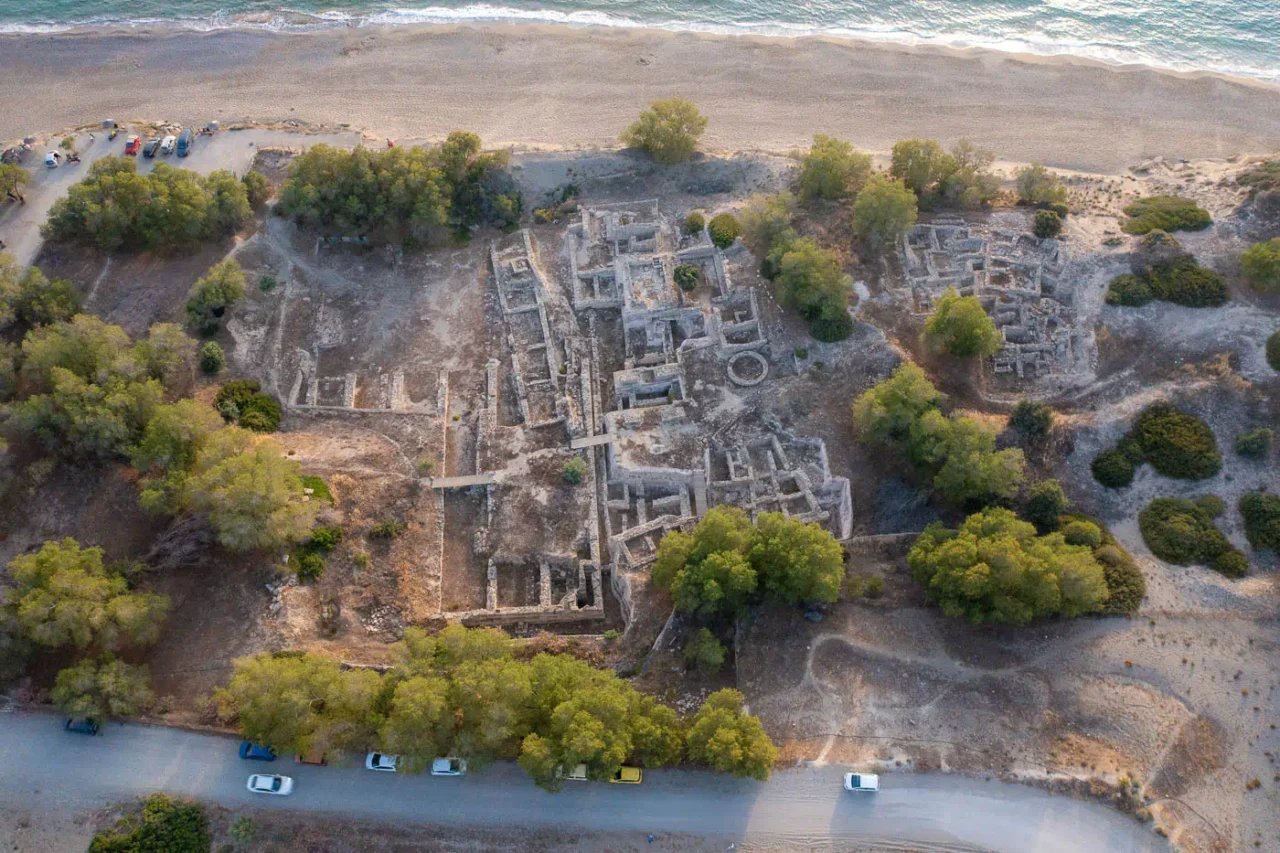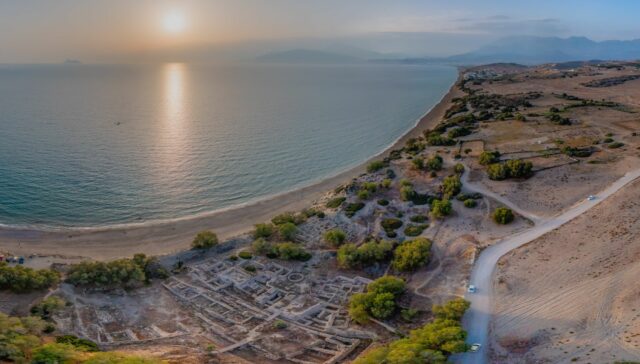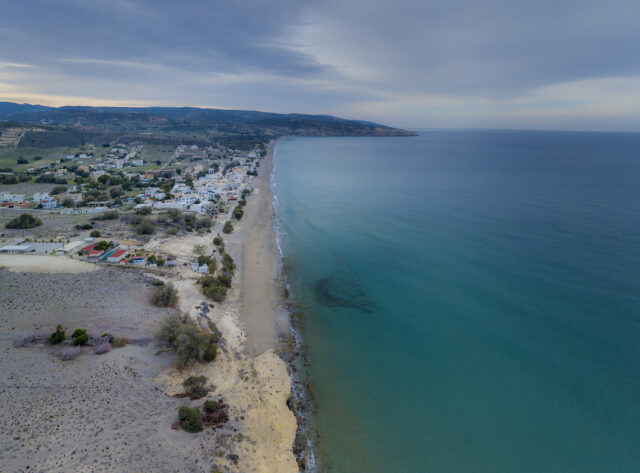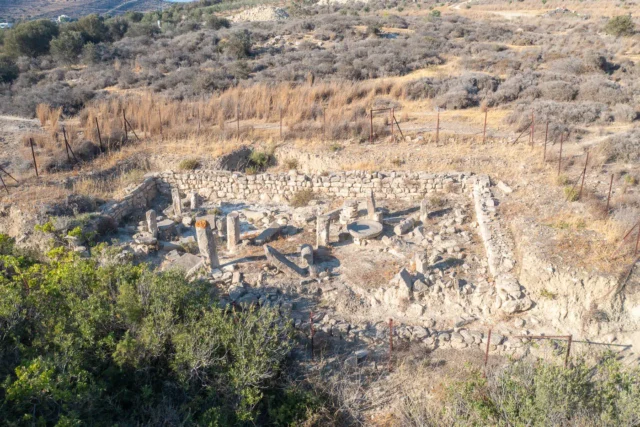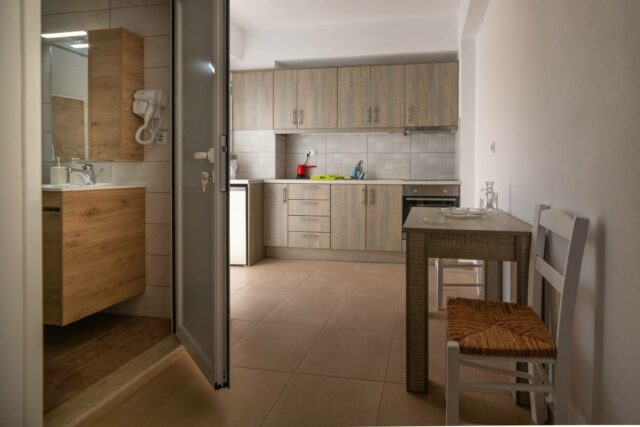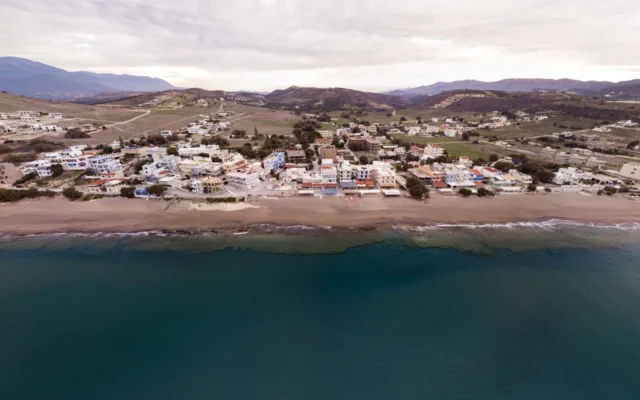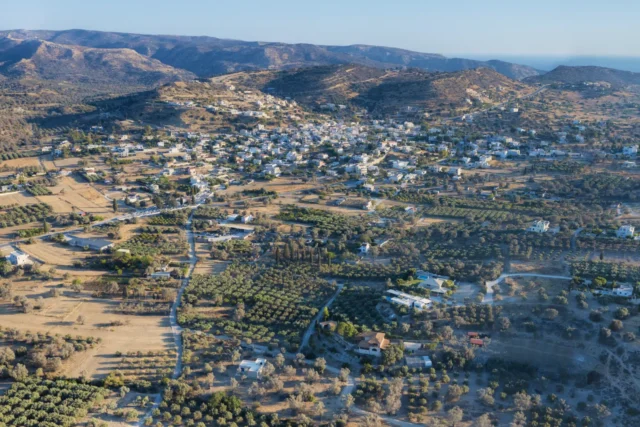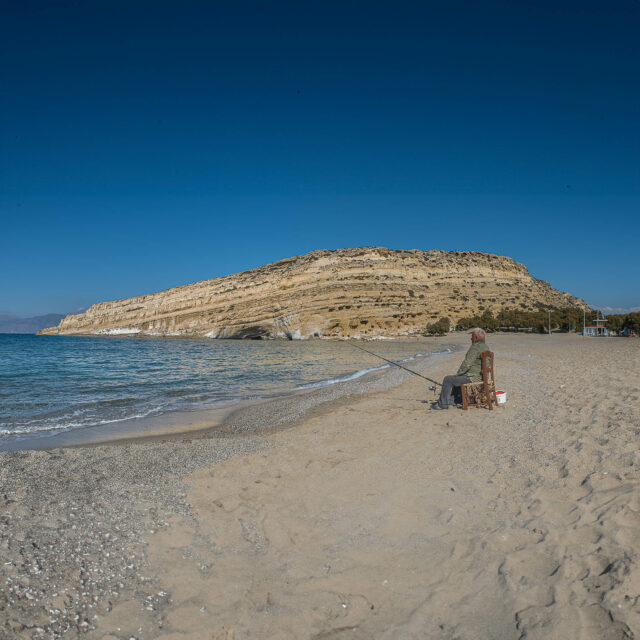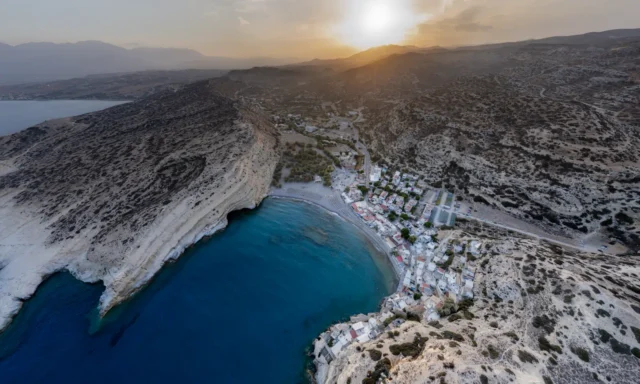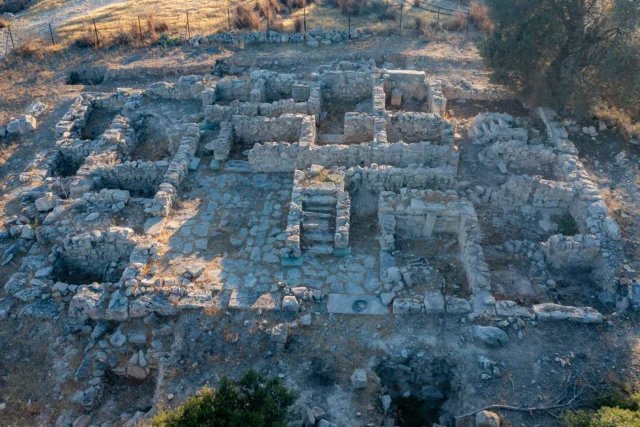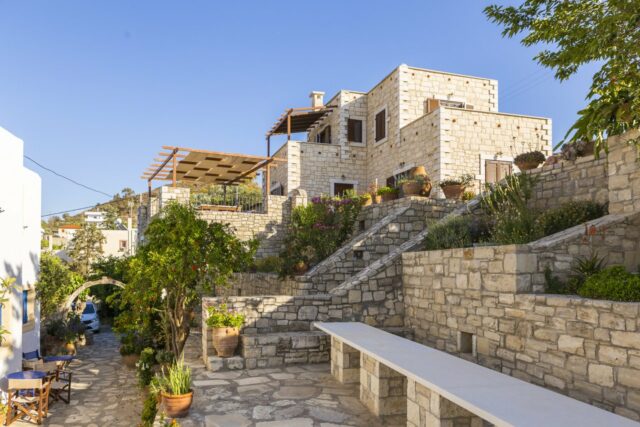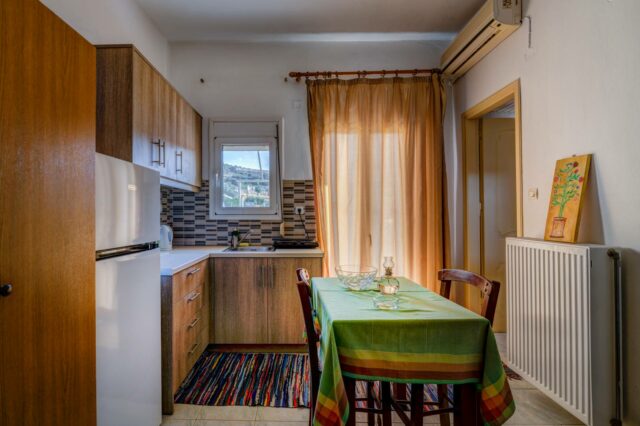Kommos is situated on the shore of the Libyan Sea (South Cretan Sea), north of Matala in south-central Crete. The archaeological site is located directly west 2.5 km from the town of Pitsidia, along the southern coast of the island of Crete, Greece, on a portion of beach that runs north-south for about 16 kilometers.
Kommos is a large Minoan and Greek site with occupation spanning from the Late Neolithic-Early Minoan periods through the Roman period. During the Minoan period, it featured a significant town and monumental structures, including possible shipsheds, indicating its role as a harbor town. In the Greek and Roman periods, the southern area transitioned to religious use with the construction of successive temples. The site was eventually abandoned and covered by sand until excavations began in 1976.
Historical Periods
Late Neolithic-Early Minoan Periods (c. 3500–2000 BCE): Sparse Occupation
During the Late Neolithic and Early Minoan (EM) periods, archaeological evidence suggests only a limited presence at the site of Kommos. Survey data indicates that during the Prepalatial period, there was a marked preference for settlement in higher locations. Consequently, the relative scarcity of remains from these earlier phases at Kommos itself might be attributed to this settlement pattern. However, the presence of a considerable scatter of Minoan sherds and continuous occupation from the EM period onwards at the nearby location of Apothestres suggests activity in the broader area. Furthermore, the large Prepalatial site of Vigles, situated a short distance south of Kommos on a hillside, is considered a potential predecessor to the Middle Minoan town of Kommos, with the later shift in location reflecting a growing interest in maritime activities. While Kommos itself shows “sparse occupation” during this extensive period, the surrounding region was not entirely uninhabited, hinting at the earliest roots that would eventually lead to the significant settlement of later periods.
Middle Minoan IA–II Periods (c. 2000–1700 BCE) – Protopalatial Period: The Kommos Town Spreads, and the First Large Civic Building (AA) is Founded
The Protopalatial Period marks a significant turning point in the history of Kommos, witnessing the spread of the town. This era, corresponding to the emergence of the first palaces elsewhere on Crete, saw Kommos develop into a more substantial settlement. Notably, the first large civic building, designated Building AA, was founded during this time. The construction of such a significant structure indicates a degree of social organization and communal effort within the developing settlement. Archaeological findings reveal that the establishment of the settlement at Kommos in the Middle Minoan IB (MM IB) phase, as well as the construction of the impressive Building AA early in Middle Minoan IIB (MM IIB), were likely connected to the ruling elite of nearby Phaistos and their interest in controlling overseas trade. It is probable that Kommos was already functioning as a harbor for arriving and departing ships even before Building AA was erected. The new excavations at Kommos have yielded a remarkable number of fragmentary vases identified as originating from outside Crete during this period, surpassing the number found at any other Protopalatial Minoan site, highlighting its burgeoning role in international exchange. At the end of this period, Building AA suffered destruction, potentially due to an earthquake, a seismic event that may have also affected Phaistos and Knossos. Despite this setback, the growth and the construction of Building AA firmly establish the Protopalatial Period as a crucial phase in the development of Kommos as a significant center.
Middle Minoan III–Late Minoan I Periods (c. 1700–1425 BCE) – Neopalatial Period: Kommos Town Expands, and Building T is Constructed
The Neopalatial Period represents a further phase of growth and prosperity for Kommos, with the town continuing to expand. A key architectural addition during this time was the construction of Building T at the beginning of the period. This monumental building complex served various functions and saw different phases of use. Interestingly, while life continued in the town, Building T gradually fell into disuse during this period, with parts of the East Wing being abandoned in early Late Minoan IA (LM IA). However, despite the decline of Building T, ample evidence in the form of non-Cretan pottery indicates that ships continued to arrive at Kommos, particularly from Cyprus and further east. This suggests that Kommos maintained its importance as a harbor despite changes in the use of its monumental structures. During LM IA Advanced and Final phases, the construction and advanced use of a kiln within the South Stoa of Building T further highlights the ongoing activities within the settlement, providing context for ceramic production around the time House X was initially built. The architectural opulence witnessed at Phaistos and Agia Triada until the end of LM IB was paralleled by the apparent flourishing of the settlement at Kommos during this time, even as Building T experienced a shift in its primary function. The interconnectedness of Kommos with other major Minoan centers like Phaistos and Agia Triada, which seem to have had distinct yet complementary roles in the region during LM I, is evident.
Late Minoan II–IIIA Periods (c. 1425–1375 BCE): Continued Occupation
The Late Minoan II (LM II) and Late Minoan IIIA periods saw continued occupation at Kommos. This phase followed the significant destructions at the end of Late Minoan IB that affected many sites across Crete. However, Kommos is notable for appearing to have had a peaceful transition from LM IB to LM II, a continuity reflected in structures like House X. During LM II, Knossian stylistic influence became dominant in local pottery production, and this trend continued into Late Minoan IIIA:1 (LM IIIA:1), when imports from beyond Crete also increased. While the sources do not provide extensive details about specific architectural developments or major events within Kommos during this relatively short timeframe beyond the ongoing occupation of existing buildings, the fact that occupation persisted indicates the resilience and continued importance of the site. Notably, the end of this period witnessed the destruction of Knossos in northern Crete, a major event that undoubtedly had repercussions across the island, although its direct impact on Kommos during this specific sub-phase is not explicitly detailed in the provided texts.
Late Minoan IIIA2–IIIB Periods (c. 1375–1200 BCE): Construction of Massive Building P During a Regional Mesara Revival, Later Abandoned Along with the Town
The Late Minoan IIIA2 and Late Minoan IIIB periods are marked by a significant regional revival in the Messara, during which the massive Building P was constructed at Kommos. This “public” structure, along with the possibly contemporary Building N, signifies a renewed phase of monumental construction at the site. Building P consisted of six galleries and likely played a crucial role in the economy of Kommos and the wider region. It has been suggested that during the Late Bronze Age, Kommos may have become a net exporter, and Building P could have served as a major distribution point, possibly for commodities like hematite or olive oil, utilizing short-necked amphorae as transport containers. This period also saw a potential expansion of population in the Western Mesara. Within the town, existing structures like House X saw changes; a destruction horizon provides much of the pottery for the LM IIIA:2 Early phase in House X, after which Knossian imports declined and local pottery diverged from Knossian models. However, this resurgence was not to last. By the end of the Late Minoan IIIB period, Kommos, including the impressive Building P and residential areas like that of House X, was abandoned along with the rest of the town. The reasons for this abandonment are still debated, but the decline of Knossos in late LM IIIA1/A2 Early led to a major regional renaissance at Agia Triada and Kommos, while Phaistos remained largely deserted at the time. This suggests a shifting regional power dynamic that may have ultimately led to the cessation of settlement at Kommos.
Late Minoan IIIC–Subminoan Periods (c. 1200–1020 BCE): The Kommos Site Lies Unoccupied Until the Founding of the First Greek Temple (A)
Following the abandonment at the end of the Late Minoan IIIB period, the site of Kommos remained unoccupied throughout the Late Minoan IIIC and Subminoan periods. This hiatus marks a significant break in the continuous occupation that had characterized Kommos for centuries. It was not until the end of this period, around 1020 BCE, that the first Greek presence is evidenced by the founding of Temple A directly above the ruins of Minoan Building T. This act signifies a shift in the cultural and religious landscape of the site, with the establishment of a Greek sanctuary in an area that had previously been a prominent part of the Minoan town.
Subminoan–Greek Geometric/Orientalizing Periods (c. 1020–600 BCE): Temples B and Building Q are Founded, Followed by Eventual Abandonment of the Sanctuary
The Subminoan, Greek Geometric, and Orientalizing Periods witnessed the further development and eventual decline of the Greek sanctuary at Kommos. Around 800 BCE, Temple B was founded above the remains of Temple A. Later in this period, Building Q was constructed. The discovery of three tapering columns resembling Phoenician deities within a temple dating to around 800 BCE suggests possible cultural interactions and influences. This period saw intense use of the sanctuary, with numerous offerings accompanying the temples. However, by the end of this era, the sanctuary was largely abandoned, marking another significant shift in the site’s function and occupation.
Archaic/Classical Periods (c. 600–400 BCE): Limited Use with an Outdoor Shrine and Building F
The Archaic and Classical Periods represent a phase of limited activity at Kommos. An outdoor shrine with a single built altar (H) and a building (F) of uncertain use are the primary archaeological indicators of this period. Some building activity during the Archaic period disturbed the uppermost Minoan strata in areas like the former location of House X. This suggests a reduced significance of the site compared to its earlier Minoan and subsequent Hellenistic phases.
Late Classical and Hellenistic Periods (c. 400–30 BCE): Rejuvenation of the Greek Sanctuary with the Founding of Temple C and Other Structures and Altars
The Late Classical and Hellenistic Periods saw a resurgence of the Greek sanctuary at Kommos. Temple C was founded above Temple B, marking the third successive temple in this location. Additionally, numerous other structures (A, B, D, E, W) and altars (C, L, M) were built around the main temple complex, indicating a renewed importance of Kommos as a religious center. This rejuvenation highlights the enduring sacred nature of the southern area of the site.
Roman Period (c. 30 BCE–CE 150): Limited Use Followed by Desertion of the Site
The Roman Period marks the final phase of occupation at **Kommos. Initially, there was limited use of the site, but eventually, it was completely deserted. A significant factor contributing to its abandonment was the accumulation of sand, drifting in from the shoreline, which began during the Early Roman period. This sand eventually covered the entire site, reaching a considerable depth of up to eight meters in some areas, particularly on the south. The site then lay deserted until the initiation of excavations in 1976.
Archaeological Discoveries
The archaeological site of Kommos in south-central Crete, north of Matala on the shore of the Libyan Sea, has yielded significant discoveries that illuminate both the Minoan and Greek periods.
Archaeological Excavations at Kommos
Systematic excavations at this extensive site commenced in 1976, an endeavor initiated by the University of Toronto. These comprehensive investigations continued for a duration of 30 years, a sustained effort led by the distinguished scholars Professors Joseph and Maria Shaw. The crucial permit that enabled these long-term excavations was generously sponsored by the esteemed American School of Classical Studies at Athens. The very first days of excavation proved remarkably fruitful, immediately revealing ancient walls alongside intriguing artifacts such as a Rhyton and a Snake Tube. These excavations brought to light numerous structures, including the significant residential building known as House X.
Notable Artifacts Uncovered at Kommos
The extensive excavations at Kommos have brought to light a diverse array of significant artifacts, offering valuable insights into the site’s history and connections. Early discoveries included ancient walls, a Rhyton, and a Snake Tube. The presence of imported pottery from various regions of the ancient world underscores Kommos‘s role in a wide network of trade that connected it to distant lands. Furthermore, an Egyptian glass vessel and fragments of copper ingots were among the finds, hinting at specific trade connections and economic activities. The discovery of two three-holed anchors provides tangible evidence of the site’s maritime importance. A particularly well-preserved fine olive press was unearthed in the Hilltop complex, offering a glimpse into the agricultural practices and economy of the Minoan inhabitants, who are also known to have kept sheep, goats, pigs, and cattle and utilized local flora like acorns, almonds, carobs, figs, beans, and grains. Within specific buildings like House X, rich and varied ceramic assemblages offer detailed insights into household pottery use across different phases, including periods of increased Knossian influence and later divergence. Finds from the LM IIIA:2 Early phase in House X, such as braziers, lamps, a unique patterned sprinkler, and a fragment possibly from a “snake tube” found in an upper story context, suggest potential cultic activities within the residence, distinct from the later public temples. The later Greek temples, constructed over the earlier Minoan ruins in the southern area, yielded a wealth of artifacts spanning the Geometric, Archaic, Classical, and Hellenistic Periods. Notably, these include tapering columns that bear a resemblance to Phoenician deities, a unique find as no other temple of this kind is known from Crete. Adding another dimension to the discoveries is a Late Minoan IA ceramic kiln found within the South Stoa of Building T, providing direct evidence of pottery production on site.
Architectural Remains from the Minoan and Greek-Roman Periods
Minoan Kommos was a substantial settlement. During the Minoan period (circa 1750 – 1250 BCE), it featured a town spanning approximately 35,000 square meters, situated on a hillside (Hillside) and higher terrain towards the north (Hilltop), which served as residential and work areas. To the south, on the flatter land bordering the shore (Southern Area), lay the civic center with a succession of three enormous structures.
House X: A Significant Minoan Residence
Among the significant residential structures uncovered is House X, a substantial Minoan mansion located near the sea, specifically on the northwestern corner of the intersection of the major east-west paved road (Road 17) and Road 32. This location placed it strategically near the boundary separating the principal residential areas from the civic center to the south. Excavated by Professors Joseph and Maria Shaw, its study provides crucial insights into domestic life, architecture, and broader cultural changes at Kommos over a long period.
Chronology and Occupation of House X: Pottery evidence indicates House X was constructed sometime after the beginning of Late Minoan IA (LM IA). The primary structure analyzed in detail is understood to be that which stood from Late Minoan IB (LM IB) Late to Late Minoan IIIA:2 (LM IIIA:2) Early times, though occupation with modifications continued into the Late Minoan IIIB (LM IIIB) period. The building underwent significant remodeling during LM IB Late. Kommos is unique among major Neopalatial sites for its apparent lack of a major destruction near the end of LM IB, showing a peaceful transition into Late Minoan II (LM II). During LM II, as evidenced by finds in House X, Knossian stylistic influence became dominant in local pottery, continuing into Late Minoan IIIA:1 (LM IIIA:1), which also saw increased non-Cretan imports. A distinct destruction horizon within House X provides most of the pottery for the LM IIIA:2 Early phase, after which Knossian and western Anatolian imports decreased, and local ceramics began diverging from Knossian models. The house, along with this sector of Kommos, was ultimately abandoned during the later LM IIIB period. Subsequent building activities in the Archaic period further disturbed the uppermost Minoan strata in this area.
Architecture and Function of House X: This well-preserved structure featured walls primarily constructed of modestly sized fieldstones, which still stood up to 2 meters high in places despite the considerable depth of prehistoric deposits (strata up to 75 cm thick). Excavations revealed the almost complete plan of more than 15 rooms. House X underwent at least three major episodes of remodeling and collapse during its long use. The rich and varied ceramic contents found within its stratified deposits offer unparalleled insights into the pottery used by a single household. Functionally, it served as a substantial private residence. During the LM IIIA:2 period, evidence suggests basement spaces were used for bulk storage (indicated by numerous large, plain closed vessels), while finds from an upper story (including braziers, lamps, a unique sprinkler, and a “snake tube” fragment) hint at possible household cult activity, although there is no compelling evidence to identify it as a public shrine.
Significance of House X: House X is exceptionally important archaeologically because it provides a unique and continuous stratigraphic sequence from the Neopalatial through the early Monopalatial periods (roughly LM IB to LM IIIA:2 Early), a rarity for Minoan Crete. Its uninterrupted occupation and well-preserved deposits allow researchers to examine in detail the crucial transition from purely Minoan material culture to the early stages of Mycenaeanized material culture in Crete during the later Late Bronze Age. The detailed study of its pottery helps trace the historical development of ceramics at Kommos and its relationship with other key sites like Knossos and Agia Triada.
Monumental Minoan Buildings: In the Southern Area, two of the large structures were palatial in nature, characterized by wings and a central court, indicative of their civic importance. The third remarkable structure appears to be six massive shipsheds. These shipsheds are particularly significant as they represent the first Minoan shipsheds ever discovered, although others have since been found at the ports of Knossos and Gournia. These structures likely served to house ships of the Cretan fleet during the winter months when sailing was less frequent. Later, during the Late MinoanIIIA2–IIIB Periods (1375–1200 BCE), a regional Mesara revival led to the construction of the massive Building P, which consisted of six galleries. While initially interpreted by excavators Joseph and Maria Shaw as potential storage shipsheds, this interpretation has been debated by others based on palaeogeographic perspectives. The later palace at Kommos (Building T) featured a large open courtyard surrounded by stoas along its north and south sides. These stoas were covered porticos that provided sheltered workspaces. The ‘North’ Stoa, similar to the one opposite it on the south, was supported by six columns and its back wall and much of its floor were adorned with colored and spiral frescos, reflecting the artistic traditions of the time. However, much of the original structure is obscured by later building activities from both the Minoan and Greek periods. Only faint traces of the earliest palace remain, further highlighting the complexities of the site’s architectural history. Building T itself was constructed at the beginning of the Neopalatial Period (1700–1425 BCE) but gradually fell into disuse while the town continued to be occupied. The first large civic building, known as Building AA, was founded during the Protopalatial Period (2000–1700 BCE) but was later destroyed, possibly by an earthquake, towards the end of this period.
During the subsequent Greek and Roman period (1025 BCE – 250 CE), the southern area of Kommos transitioned from commercial to religious use. Three successive temples were constructed directly upon each other, a practice accompanied by numerous votive offerings. These temples were all situated on the ruins of earlier Minoan buildings, creating a unique architectural palimpsest. Various other structures were erected around these temples, including four altars dating to the final phase of the sanctuary when the deities Zeus and Athena were worshipped. Together, the temples and the underlying Minoan palatial walls represent an architectural assemblage that is unique on Crete, emphasizing the site’s long and layered history. Around 800 BCE, Temple B was founded above Temple A, and Building Q was constructed later. After a period of intense use, the sanctuary was largely abandoned at the end of this period. Limited use occurred during the Archaic/Classical Periods (600–400 BCE), evidenced by an outdoor shrine with a single built altar (H) and a building (F) of uncertain purpose. The Late Classical and Hellenistic Periods (400–30 BCE) saw a rejuvenation of the Greek sanctuary with the founding of Temple C above Temple B, followed by the construction of numerous other structures (A, B, D, E, W) and altars (C, L, M). By the Roman Period (30 BCE–CE 150), the site experienced limited use before being completely deserted.
Current State
The Kommos archaeological site currently faces significant environmental challenges, primarily erosion and the accumulation of sand drifting in from the shoreline. During the Early Roman period, sand began to cover the site, eventually reaching depths of up to eight meters in some areas, particularly in the south. The area remained deserted until 1976. Recognizing the importance of this site, ongoing conservation efforts are crucial to protect its well-preserved remains. These efforts include addressing drainage issues, managing erosion, and stabilizing the ancient walls. Notably, private funds have supported masonry stabilization efforts for 20 years following the end of excavations. To further safeguard the site, protective roof structures have been designed and constructed over the Greek temples and the kiln in the south stoa. The design of these shelters, undertaken by experienced Greek conservation architects Clairy Palyvou and Sonia Mavrommati, takes into account safety standards, environmental conditions, and interpretive viewing locations for visitors, opting for arched metal structures with specialized coatings to withstand the salt air environment. Plans are actively being developed for the creation of an archaeological park at Kommos. This initiative aims to ensure the long-term stewardship of the site and to provide demonstrable public benefit by creating walkways, viewing areas, and interpretive media stations to educate visitors about the site’s rich history and significance. The conceptual master plan for the park, first conceived in 1998 and updated in 2005 and 2015, includes considerations for public safety and amenities. Future excavation and research are also planned, with particularly important areas such as well-preserved Middle Minoan houses on the hillside and the remaining shipshed galleries awaiting further investigation. The Kommos Conservancy plays a vital role in supporting these ongoing conservation and research efforts.
Cultural and Economic Context of Kommos
Economic Importance of Kommos
The coastal site of Kommos held significant economic importance throughout its occupation, primarily due to its strategic location on the southern coast of Crete. Serving as the harbor town for the major inland centers of Phaistos and Agia Triada, Kommos naturally became a crucial point for maritime trade and exchange. This role as an “epineion” facilitated the flow of goods and raw materials to and from the fertile Messara plain, contributing to the prosperity of the inland settlements and connecting them to broader Mediterranean trade networks. The ease of access to the sea allowed for connections with distant lands such as Cyprus, Egypt, and Syria, as evidenced by archaeological finds indicating the presence of imported pottery and other exotic goods. Travelers arriving by sea would have likely made landfall at Kommos before journeying inland to visit important centers like Phaistos, highlighting the site’s function as a gateway. The later discovery of similar shipsheds at the ports of Knossos and Gournia, after the initial findings at Kommos, suggests a shared understanding and practice of maritime infrastructure across Minoan Crete, further emphasizing the economic significance of seafaring and harbor facilities.
Evidence from the site itself reveals the diverse economic activities undertaken by its inhabitants. Agriculture played a vital role, with the raising of sheep, goats, pigs, and cattle, alongside the cultivation of various crops, including acorns, almonds, carobs, figs, beans, and grains. The production of wine and olive oil, the latter evidenced by the presence of a fine olive press, indicates local processing of agricultural products. Additionally, the grinding of grain suggests a degree of self-sufficiency in food production. The discovery of a Late Minoan IA ceramic kiln at Kommos provides direct evidence for local pottery production. This indicates that the inhabitants not only relied on imported ceramics but also possessed their own craft specialization in this area. Furthermore, the presence of evidence for purple dyeing in Building AA hints at textile production, a significant aspect of the Minoan economy known for its high-quality textiles traded across the Aegean.
Archaeological finds further underscore the importance of trade at Kommos. The presence of imported pottery from various regions, an Egyptian glass vessel, and copper ingots directly attests to the site’s involvement in active trade networks [previous conversation]. During the Late Bronze Age, Kommos may have evolved to become a net exporter of raw materials or agricultural produce, potentially utilizing a new form of transport container, the short-necked amphora. Building P at Kommos likely served as a major distribution point for these vessels, possibly containing valuable commodities such as hematite or olive oil. Even local fishing activities would have contributed to the sustenance and economy of the settlement. The overall picture is of a vibrant coastal settlement that thrived as a crucial node in the Minoan economic system, facilitating both local production and long-distance exchange.
Cultural Evolution at Kommos
The cultural landscape of Kommos underwent a significant transformation over time, particularly in the utilization of its southern area. Initially serving commercial purposes during the Minoan period, this part of the site transitioned to religious functions in the subsequent Greek and Roman periods, marking a profound cultural shift. The construction of three successive temples in this area indicates a continuity of religious activity across these later periods. The final phase saw the establishment of a temple dedicated to the prominent Greek deities Zeus and Athena, highlighting the integration of Kommos into the broader Greek religious world. Notably, a temple dating back to around 800 BCE contained columns resembling Phoenician deities, suggesting continued international connections and potential syncretism in religious beliefs. The discovery of numerous votive offerings within these temple structures further underscores the religious importance of Kommos during the Greek and Roman periods, indicating that the site remained a significant place of worship for centuries.
During the Late Minoan III period, a distinct cultural practice is suggested by the presence of tomb models found exclusively in residential contexts, such as the possible cult-related items found in House X during the LM IIIA:2 Early phase. This localization of such artifacts points towards the existence of a household cult of the dead and possibly ancestor veneration. These models, often cylindrical terracotta structures, may have served as symbolic representations of tholos tombs, which saw increased use during this period, indicating evolving funerary customs and beliefs. The shift towards more elaborate burial practices and the emergence of burial-related imagery during Late Minoan III further support this idea of changing cultural attitudes towards death and remembrance. The evidence from House X specifically highlights how these evolving practices might manifest within a domestic setting during the crucial transition towards Mycenaean influence.
Even in the Geometric period, following the decline of the Minoan palatial system, Kommos witnessed a re-establishment of international connections alongside the presence of a shrine at the site [previous conversation]. This suggests a resilience in cultural practices, particularly in the realm of religious expression and interaction with the wider Mediterranean world. The long history of occupation at Kommos, spanning from the Minoan Bronze Age through the Greek and Roman periods, reveals a site of enduring economic and cultural significance, adapting and evolving in response to changing social, political, and religious landscapes. The ongoing conservation efforts at Kommos, including the creation of public walkways and viewing areas, aim to allow visitors to understand the site’s fifteen hundred year evolution, highlighting the deep historical and cultural layers preserved there.
Key Points
- Location and Accessibility: Southern coast of Crete, near Matala and Pitsidia, on the shore of the Libyan Sea.
- Dimensions: The Minoan town covered approximately 35,000 square meters.
- Active Historical Periods: Significant activity during the Middle Minoan to Late Minoan periods, and again during the Greek and Hellenistic periods.
- Historical Significance: Major Minoan harbor town and potential shipshed location, indicating maritime importance and trade connections. Contains significant residential buildings like House X, providing detailed insights into Minoan life and cultural transitions. Later served as a significant Greek religious sanctuary with a unique architectural continuity from the Minoan era.
- Current Status: Archaeological site undergoing conservation, with plans for an archaeological park to enhance preservation and public access.

